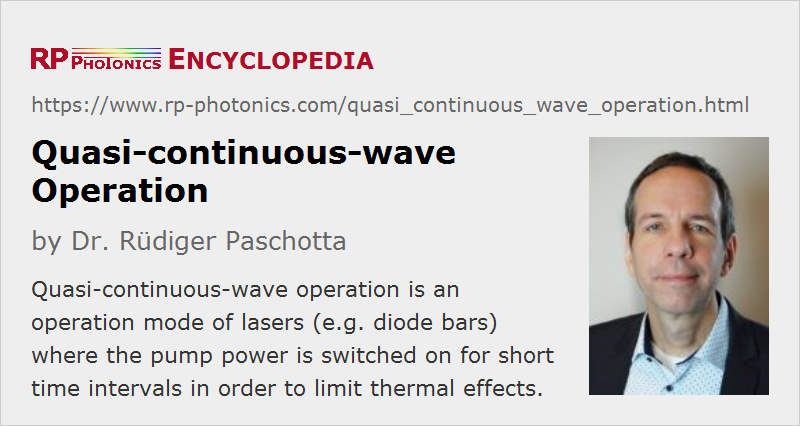Quasi-continuous-wave Operation
Definition: an operation mode of lasers (e.g. diode bars) where the pump power is switched on for short time intervals in order to limit thermal effects
German: Quasi-CW-Betrieb, quasi-kontinuierlicher Betrieb
Categories:  laser devices and laser physics,
laser devices and laser physics,  light pulses
light pulses
Author: Dr. Rüdiger Paschotta
Cite the article using its DOI: https://doi.org/10.61835/kpr
Get citation code: Endnote (RIS) BibTex plain textHTML
Quasi-continuous-wave (quasi-cw) operation of a laser means that its pump source is switched on only for certain time intervals, which are short enough to reduce thermal effects significantly, but still long enough that the laser process is close to its steady state, i.e. the laser is optically in the state of continuous-wave operation. The duty cycle (percentage of “on” time) may be, e.g., a few percent, thus strongly reducing the heating and all the related thermal effects, such as thermal lensing and damage through overheating. Therefore, quasi-cw operation allows the operation with relatively high output power during limited time intervals.
Pulsed operation with much shorter pumping times, where an optical steady state is not reached, is called gain switching.
Quasi-continuous-wave operation is most often used with diode bars and diode stacks. Such devices are sometimes even designed specifically for quasi-cw operation: their cooling arrangement is designed for a smaller heat load, and the emitters can be more closely packed in order to obtain a higher brightness and beam quality. Compared with ordinary continuous-wave operation, additional lifetime issues can result from quasi-cw operation, related e.g. to higher optical peak intensities or to frequent temperature changes.
Some doped-insulator solid-state lasers are also operated in quasi-cw operation. Such lasers are sometimes called heat capacity lasers.
Mode-locked Lasers
In an entirely different sense, mode-locked operation of a laser could be considered as quasi-continuous operation. Due to the very high pulse repetition rate, where the pulse energy is typically very far below the saturation energy of the laser gain medium, gain saturation is essentially the same as for continuous-wave operation with the same average power. The performance in terms of average power can thus be calculated as for a continuous-wave laser. However, the term quasi-continuous-wave operation is usually not applied to that situation.
More to Learn
Encyclopedia articles:
Bibliography
| [1] | T. Dascalu et al., “100-W quasi-continuous-wave diode radially pumped microchip composite Yb:YAG laser”, Opt. Lett. 27 (20), 1791 (2002); https://doi.org/10.1364/OL.27.001791 |
| [2] | C. Y. Li et al., “QCW diode-side-pumped Nd:YAG ceramic laser with 247 W output power at 1123 nm”, Appl. Phys. B 103 (2), 285 (2010); https://doi.org/10.1007/s00340-010-4228-y |
| [3] | M. Hübner et al., “A 1.4 kW 780 nm pulsed diode laser, high duty cycle, passively side-cooled pump module”, Opt. Express 29 (7), 9749 (2021); https://doi.org/10.1364/OE.416527 |
Questions and Comments from Users
2023-09-06
Suppose I've got a 100 W QCW laser with a duty of 0.2%. Does this mean that I am to operate the laser with 100 W drive power for 0.2% of the time. If so, the average power of this laser would seem to be very substantially less than 100W, right? A 100W CW laser accepts 10A x 10V without interruption.
The author's answer:
I suspect that the 100-W rating applies to the output power, not the drive power, but you need to check that with the data sheet.
That low duty cycle would indeed result in a rather low average power of only 0.2 W. The laser would only need accordingly simple means for cooling, resulting in a rather compact setup.
Here you can submit questions and comments. As far as they get accepted by the author, they will appear above this paragraph together with the author’s answer. The author will decide on acceptance based on certain criteria. Essentially, the issue must be of sufficiently broad interest.
Please do not enter personal data here; we would otherwise delete it soon. (See also our privacy declaration.) If you wish to receive personal feedback or consultancy from the author, please contact him, e.g. via e-mail.
By submitting the information, you give your consent to the potential publication of your inputs on our website according to our rules. (If you later retract your consent, we will delete those inputs.) As your inputs are first reviewed by the author, they may be published with some delay.



2021-11-06
Is it safe for the laser to operate a high-power (e.g. 200 W) CW diode (or diode array) in QCW mode? Assume a well-designed QCW driver operating at a de-rated peak current, and ignoring any electromagnetic effects of the power leads (e.g. parasitic induction).
The author's answer:
That should normally be safe as long as the pulse current does not exceed the rated continuous-wave current. The inductance of power leads should not be a problem, particularly if the current slope is not unnecessarily high. To be fully sure, you should ask the supplier of the laser.